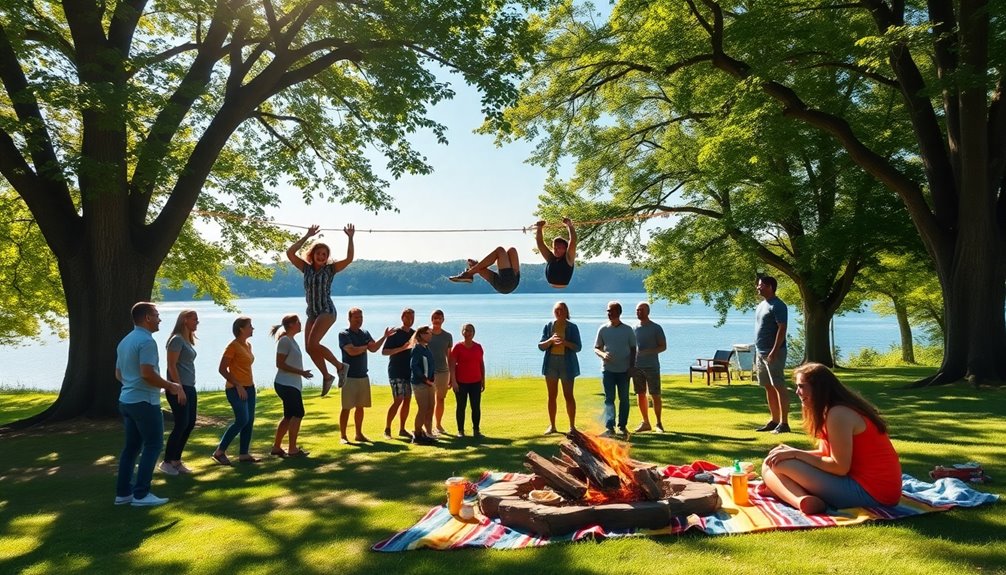For a successful team building retreat, consider a mix of activities that unite and inspire. Start with icebreakers to set a relaxed mood. Incorporate wellness sessions like yoga or meditation to enhance mental well-being. Adventure activities, such as zip-lining, can energize your team. Workshops, whether cooking or art-related, spark creativity and collaboration. Adding community service projects fosters meaningful connections. Don't forget to gather input from your team during planning to guarantee everyone feels involved. Balancing structured workshops with informal interactions strengthens bonds. Keep going, and you'll discover even more ideas to make your retreat unforgettable.
Key Takeaways
- Incorporate wellness activities like yoga and meditation to promote mental well-being and team support.
- Organize adventure-based outings, such as zip-lining or hiking, to energize teams and build camaraderie.
- Engage in creative workshops like art classes or cooking sessions to foster collaboration and innovative thinking.
- Facilitate community service projects, allowing teams to bond through meaningful engagement and shared goals.
- Plan interactive games, such as scavenger hunts, to enhance communication skills and problem-solving abilities within the team.
Definition of Company Retreats
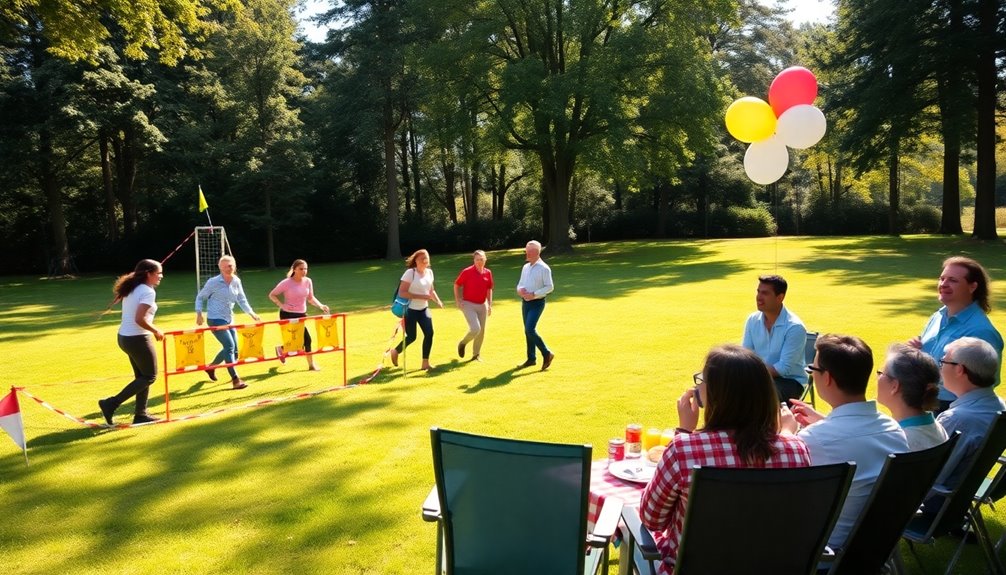
When you think about company retreats, imagine immersive experiences that extend beyond a typical workday, often lasting at least a day or two.
These retreats provide a unique opportunity for team bonding in an environment away from the office. By stepping outside the workplace, you and your colleagues can foster deeper connections and personal growth, enhancing team cohesion.
Activities during these retreats can range from workshops to outdoor adventures, allowing you to engage in experiences that are hard to replicate during regular workdays. The focus on team bonding not only boosts creativity but also strengthens overall workplace culture.
Plus, involving employees in the planning guarantees diverse representation and a sense of ownership, making the retreat even more impactful.
Types of Retreat Activities

Whether you're aiming for relaxation or adventure, the types of activities you choose for your retreat can greatly impact team dynamics.
Consider incorporating wellness-focused events like yoga and meditation to promote mental well-being. Alternatively, adventure-based experiences such as skiing or zip-lining can energize your team.
Creative workshops, like art classes or cooking sessions, foster collaboration and spark creativity, encouraging teamwork in a fun environment. Community service projects also provide meaningful engagement, allowing team members to connect while giving back.
Additionally, outdoor retreats, including hiking, enable informal interactions and strengthen relationships through shared challenges.
Finally, interactive games like scavenger hunts enhance communication and problem-solving skills, making them excellent team building activities that unite and inspire your team. Incorporating elements of eco-friendly glamping can also create a unique retreat experience that encourages sustainability and connection to nature.
Planning and Team Involvement
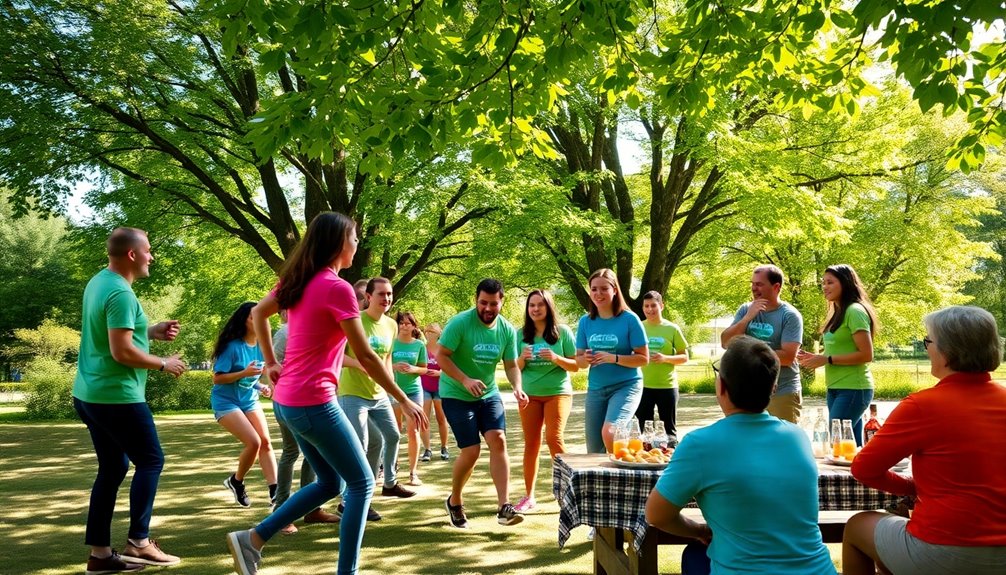
Involving your team in the planning of a retreat not only boosts engagement but also assures that diverse perspectives and interests are represented. By creating a detailed itinerary with employee input, you maintain excitement and provide a clear structure for activities, enhancing overall participation. Regular updates during the planning phase keep team members informed and motivated, fostering ownership and commitment. Here's a quick overview of ideas for effective planning:
| Planning Aspect | Activity Ideas |
|---|---|
| Team Brainstorming | Collect ideas for activities |
| Feedback Sessions | Discuss preferences for topics |
| Role Assignments | Delegate planning tasks |
| Progress Updates | Share retreat developments |
| Post-Retreat Surveys | Gather feedback for future events |
Encouraging contributions assures activities resonate with everyone, leading to a successful retreat.
Balancing Activities and Team Building
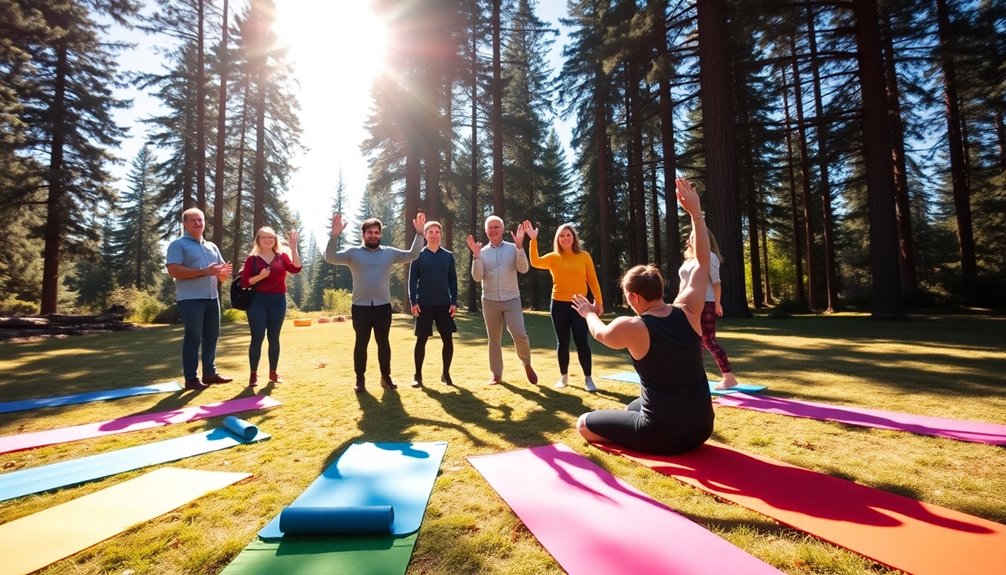
To create a successful team-building retreat, it's essential to balance structured activities with informal interactions. Start with icebreaker activities to ease participants into team dynamics and foster connections.
Incorporate a mix of team-specific exercises and cross-team activities to enhance collaboration across departments. This balance not only promotes understanding but also encourages engaging team building.
Don't forget to allocate time for both serious workshops focused on skill development and lighter, unstructured activities that spark creativity and relaxation.
Regularly assess the effectiveness of your chosen team building activities through participant feedback to guarantee they resonate with everyone's needs.
Capturing Memories and Engagement

Capturing memories during a team-building retreat not only enhances engagement but also strengthens the bonds among participants.
Designate photographers to document key moments, contributing to a shared digital album that fosters community and nostalgia. Encourage everyone to journal or share on social media; this not only boosts engagement but also helps create lasting memories of the experience.
After the retreat, compile highlight videos to recap the event visually, reinforcing team bonding and motivating future initiatives.
During wrap-up sessions, allow attendees to share their favorite moments—this reflection promotes deeper connections.
Finally, use engaging hashtags for social media posts to increase visibility and foster a sense of belonging among team members.
Year-Round Engagement Strategies
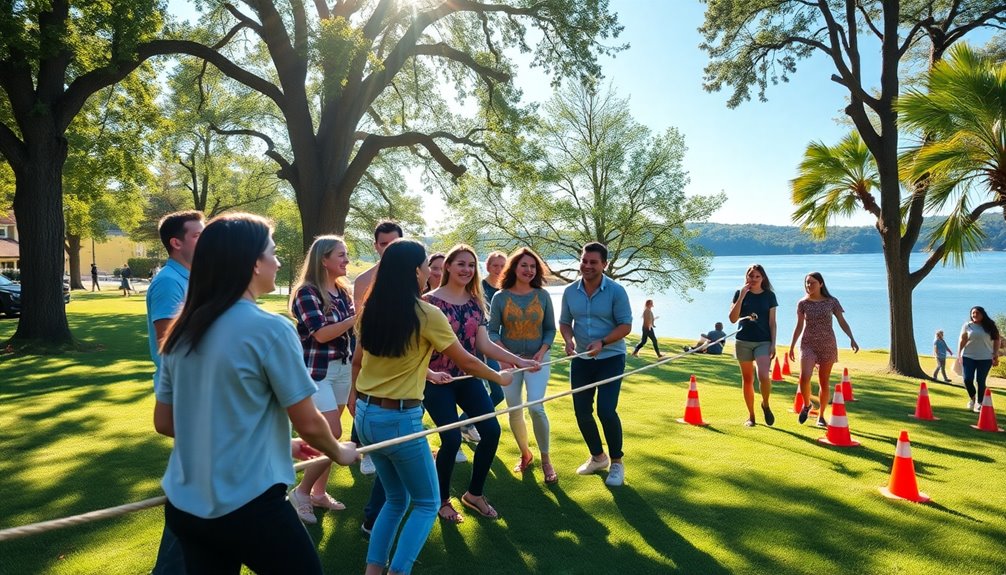
While team-building retreats can create a strong foundation for collaboration, maintaining that momentum year-round is essential for lasting success. Incorporate regular team-building activities throughout the year to strengthen relationships developed during retreats.
Schedule quarterly check-ins to assess team dynamics and tackle any challenges, fostering a culture of continuous improvement. Encourage ongoing collaboration by creating cross-team projects that promote interaction and shared goals among different departments.
Implement recognition programs to celebrate team achievements and individual contributions, reinforcing a culture of appreciation and motivation. Additionally, integrate wellness activities, like monthly yoga sessions or wellness challenges, to support employee health and well-being beyond the retreat experience. Offering unique amenities, such as gourmet dining, can also enhance the overall experience and strengthen team bonds.
These strategies guarantee your team stays connected and engaged all year long.
Addressing Seasonal Challenges
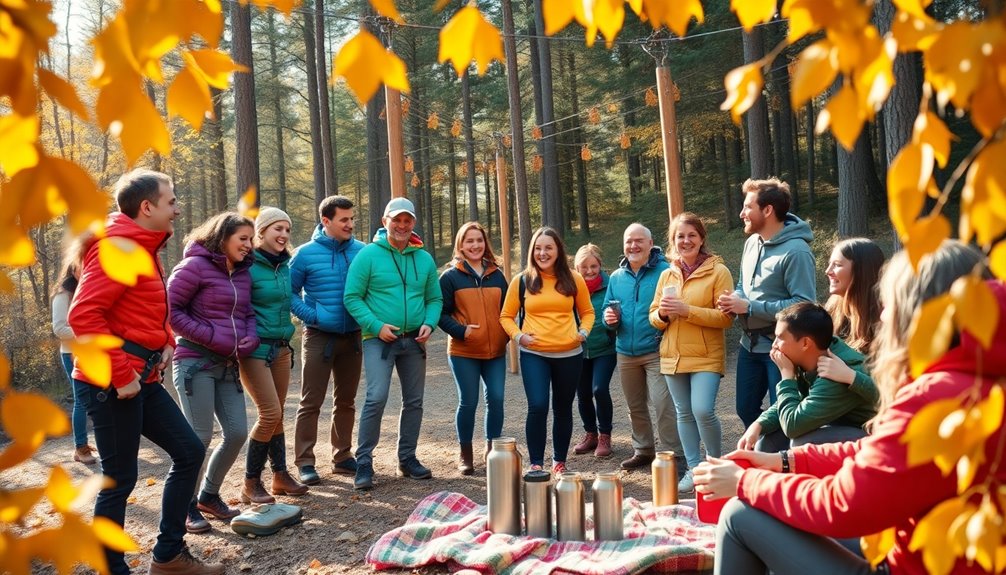
As seasons change, it's important to recognize how they can impact your team's mood and productivity.
By implementing flexible work arrangements, you can help your colleagues manage seasonal challenges more effectively.
Let's explore how awareness and adjustments can create a more supportive work environment during these changes. Additionally, incorporating visualization techniques can enhance team cohesion and motivation during retreats.
Seasonal Mood Awareness
Understanding how seasonal changes affect mood and productivity can help you create a more supportive workplace. Around 20% of employees may experience Seasonal Affective Disorder (SAD) during winter months, so it's essential to address these challenges.
Incorporating wellness activities in your team building retreats can considerably boost morale and reduce stress. Encourage participation in outdoor activities to capitalize on natural light and physical movement, both known to enhance mental health.
Providing resources for mental health support during tougher seasons is also critical. By fostering employee engagement through awareness and proactive measures, you demonstrate your commitment to their well-being, ultimately improving retention and satisfaction rates within your team.
Flexible Work Arrangements
Seasonal challenges can prominently impact employees, making flexible work arrangements an effective solution. By implementing remote work options or adjusted hours, you provide your team with the flexibility they need to juggle personal commitments and seasonal stressors.
This can greatly boost employee morale, as a 2022 survey revealed that 70% of employees felt better mentally with flexible schedules during tough seasonal periods. Additionally, these arrangements can reduce burnout and increase retention rates by up to 25%.
Incorporating team building activities that align with these flexible work policies further strengthens bonds among team members, fostering a supportive environment. Ultimately, prioritizing flexible work arrangements enhances overall job satisfaction and productivity during challenging times.
Recognizing Peers and Rewards

Recognizing peers and rewarding their contributions can greatly boost team morale and engagement.
When you create a culture of appreciation, you foster team bonding and increase motivation.
Here are some effective strategies:
- Implement a peer recognition program to celebrate achievements regularly.
- Offer diverse incentives like gift cards, public shout-outs, or extra time off.
- Conduct regular assessments to understand what recognition resonates most with your team.
- Celebrate milestones through team events or meetings to reinforce positive behaviors.
Additionally, creating a supportive environment can help counteract gaslighting and maintain emotional stability among team members.
Supporting Employee Well-Being
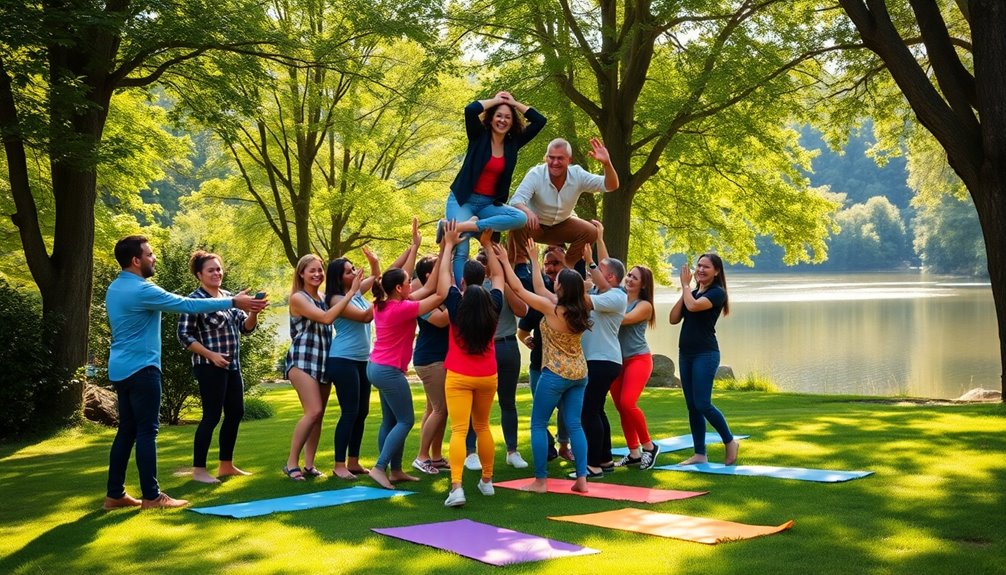
To support employee well-being, you can integrate mental health initiatives and wellness activities into your team building retreats.
Offering sessions like yoga and meditation not only reduces stress but also fosters a more resilient and engaged workforce. Additionally, incorporating mindfulness practices can enhance focus and emotional regulation among team members.
Mental Health Initiatives
While many organizations focus on traditional productivity metrics, investing in mental health initiatives can dramatically transform employee well-being.
By prioritizing mental health, you're not only enhancing morale but also boosting productivity and reducing absenteeism.
Consider integrating these team-building activities to support your employees:
- Offer mental health days to recharge and refresh.
- Provide access to counseling services for added support.
- Organize mindfulness and stress management workshops.
- Conduct regular mental health check-ins to foster open communication.
These initiatives can lead to a 25% increase in productivity and a 30% reduction in absenteeism, creating a culture of empathy and understanding. Research shows that engaging in these activities enhances team cohesion and greatly contributes to overall employee well-being.
Wellness Activities Integration
Integrating wellness activities into your team-building retreats can greatly enhance employee well-being, as these experiences foster a supportive and engaging environment. Activities like yoga, meditation sessions, and nature walks can reduce stress and promote mental clarity, leading to improved morale.
Wellness workshops focused on emotional intelligence and stress management enhance team dynamics by encouraging open communication and empathy. Outdoor mindfulness exercises encourage physical activity while promoting tranquility, further supporting overall well-being.
Offering healthy meal options sustains energy levels and cultivates healthier eating habits. Incorporating peer recognition programs and wellness challenges boosts employee engagement, creating a work culture that prioritizes mental and emotional health year-round. Additionally, integrating mindfulness practices can enhance self-awareness and resilience among team members.
Frequently Asked Questions
What Are Team Building Activities at Retreats?
Team building activities at retreats focus on enhancing communication and trust among you and your colleagues.
You might participate in outdoor challenges, creative workshops, or problem-solving games tailored to your team's dynamics. These activities encourage deeper bonding and understanding, boosting morale and fostering a stronger company culture.
Icebreakers and competitive games not only entertain but also promote meaningful interactions, ultimately strengthening your professional relationships and improving collaboration within your team.
What Are the Fun Activities for Team Building?
Imagine the thrill of racing against the clock in an escape room, where each puzzle solved sparks laughter and teamwork.
Or picture yourself maneuvering a lively scavenger hunt, strategizing with teammates as you uncover hidden treasures.
Cooking classes let you whip up delicious meals together, bonding over shared creations.
Outdoor Olympics ignite friendly competition, while art workshops release your creativity, connecting everyone through vibrant expressions.
These activities not only entertain; they unite and inspire your team.
What Are the 4 Main Types of Team Building Activities?
The four main types of team building activities are icebreakers, problem-solving games, creative workshops, and outdoor adventures.
Icebreakers help you get to know your teammates in a fun way.
Problem-solving games challenge you to think critically and collaborate effectively.
Creative workshops let you express yourself and bond through shared creativity.
Finally, outdoor adventures promote physical activity and casual interaction, allowing you to strengthen relationships in a relaxed setting.
What Is the Best Game for a Group Retreat?
For a group retreat, the best game is the Escape Room Challenge.
You'll plunge into an immersive experience that requires you and your teammates to solve puzzles under pressure.
It'll sharpen your problem-solving skills and enhance communication, all while having a blast.
As you work together to escape within the time limit, you'll build trust and camaraderie, making it a memorable and unifying experience for everyone involved.
Conclusion
As you commence your team building retreat, remember that these moments together are more than just activities—they're invaluable opportunities to strengthen bonds and nurture a sense of belonging. Embrace the laughter, the shared stories, and the growth that comes from stepping outside your comfort zone. By fostering connection and recognizing each other's contributions, you create a workplace where everyone feels valued and inspired. So, go ahead and make lasting memories that will carry your team through the seasons ahead.
